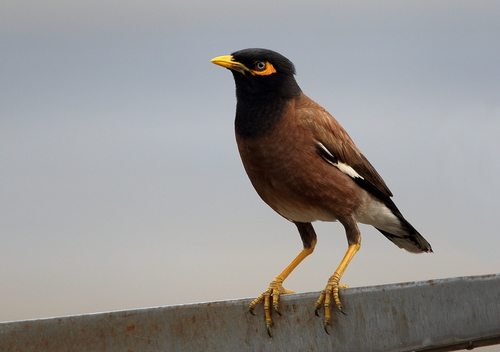
Common Myna
The Common Myna (Acridotheres tristis) is a highly adaptable and widespread bird species, originally from Asia, but now found in many parts of the world. Known for its bold behavior and distinctive vocalizations, it plays a complex ecological role, sometimes beneficial as a pest controller and sometimes detrimental as an invasive species. It holds cultural significance in some regions, often appearing in folklore and literature, and is sometimes kept as a pet due to its ability to mimic human speech.
23-26 cm
Length
120-142 mm
Wingspan
Least Concern
Conservation Status
Distribution
Native to South and Southeast Asia, the Common Myna has been introduced to many other regions, including Australia, North America, South Africa, the Middle East, and various islands in the Pacific, Atlantic, and Indian Oceans. It is a non-migratory species, although some populations may make local movements in response to food availability.
Lifespan
Typically 4 years in the wild, but up to 12 years in captivity.
Common Myna's Habitat
Habitat Types
Urban areas, Agricultural lands, Open woodlands, Grasslands, Suburban gardens
Climate Zones
Tropical, Subtropical, Temperate
Adaptations
Highly adaptable to various environments, the Common Myna thrives in human-modified landscapes. Its ability to utilize a wide range of food sources and nesting sites contributes to its success in diverse habitats.
Variations
Several subspecies have been described, differing slightly in size and plumage coloration. For example, the Indian Myna (A. t. tristis) is the most widespread, while the Sri Lankan Myna (A. t. melanosternus) has a darker breast.
Appearance
Breeding Plumage
No significant differences between breeding and non-breeding plumage.
Seasonal Feather Changes
No major seasonal variations.
Sex Based Plumage Differences
Males and females have similar plumage.
Notable Features
Brown body with a black head and neck, Yellow beak, legs, and bare skin around the eyes, White wing patches visible in flight, White tail tip
Diet and Feeding
Primary Foods
Insects, Fruits, Seeds, Nectar, Human food scraps
Foraging Behavior
Forages primarily on the ground, often in open areas. They walk with a distinctive strut, pecking and probing for food. They are also known to hawk insects in the air and forage in trees for fruits and nectar.
Specializations
Their generalist diet and opportunistic feeding behavior allow them to thrive in diverse environments and exploit various food resources.
Seasonal Diet Variations
Diet may shift depending on food availability. For example, they may consume more insects during the breeding season when protein requirements are higher, and more fruits and seeds during other times of the year.
Behavior
Social Structure
Highly social, often found in pairs or small flocks, especially outside the breeding season. They can form large communal roosts at night, sometimes numbering thousands of birds.
Communication
Wide range of vocalizations, including calls, songs, and mimicry, Head bobbing, Wing fluttering, Posturing
Migration
Generally non-migratory, but some populations may make local movements in response to food availability.
Territorial or Group Behaviors
During the breeding season, pairs defend territories around their nest sites. Outside the breeding season, they are more gregarious and may forage and roost together.
Conservation
Threats
Considered a pest in many introduced regions, Competition with native species, Predation on eggs and nestlings of other birds, Agricultural damage
Protection Programs
No specific protection programs due to its abundance and pest status in many areas.
Local National Laws
In some regions, it is considered an invasive species and may be subject to control measures.
Population Trend
Stable
Population Estimates
Abundant and widespread; global population estimates are not precisely quantified but are in the millions.
Interesting Facts
They are excellent mimics
Common Mynas can imitate a wide range of sounds, including human speech, other bird calls, and even mechanical noises.
They are considered one of the most invasive bird species in the world
Their adaptability and aggressive behavior have allowed them to establish populations and outcompete native species in many introduced regions.
They have a distinctive walking style
Common mynas have a characteristic 'strut' and walk on the ground rather than hop.
They form strong pair bonds
Common Mynas often mate for life and maintain their pair bond throughout the year.
Faqs about Common Myna
Are Common Mynas good pets?
While they can be tamed and are capable of mimicking human speech, they are generally not recommended as pets due to their messy habits, loud vocalizations, and potential for aggressive behavior. Also, keeping them might be illegal in some regions where they are considered an invasive species.
Why are Common Mynas considered pests?
They are considered pests in many areas because they compete with native birds for resources, prey on the eggs and nestlings of other species, damage crops, and can spread weeds. Their droppings can also be a nuisance in urban areas.
What should I do if I find a Common Myna nest?
If the nest is in an area where Common Mynas are considered invasive, it's best to contact your local wildlife authority for advice. In some cases, nest removal may be recommended to help control their populations. If not considered invasive, you should leave it alone.
How can I tell a Common Myna from other similar birds?
Look for the combination of a brown body, black head, yellow beak and eye patch, and white wing patches visible in flight. Their distinctive strutting walk is also a good identifying characteristic.
Copyright @ Nature Style Limited. All Rights Reserved.
 English
English